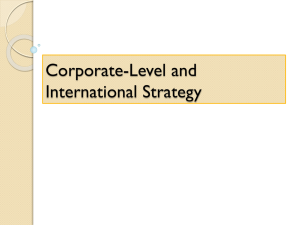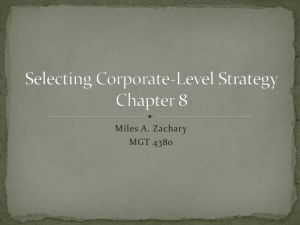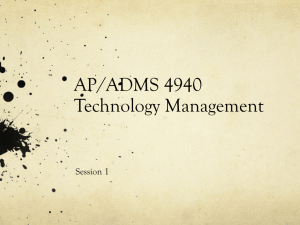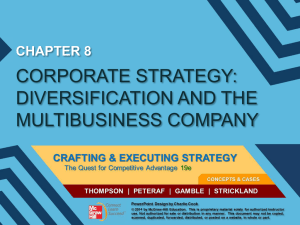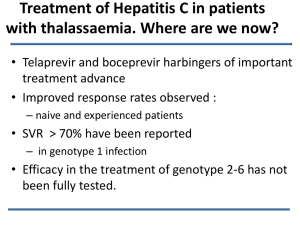Hypothesis 2
advertisement
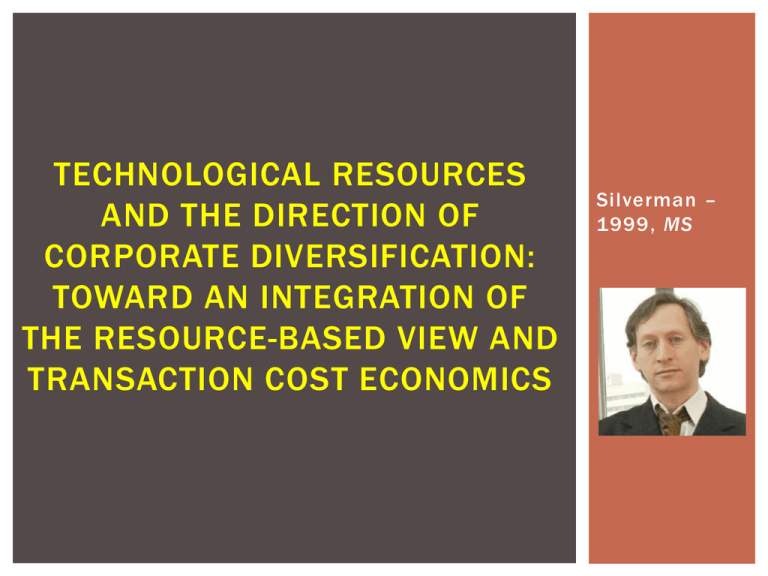
TECHNOLOGICAL RESOURCES AND THE DIRECTION OF CORPORATE DIVERSIFICATION: TOWARD AN INTEGRATION OF THE RESOURCE-BASED VIEW AND TRANSACTION COST ECONOMICS Silverman – 1999, MS OVERVIEW A study of how a firm’s resource base af fects the choice of industries into which the firm diversifies Silverman (1999) integrates principles of both the Resource-based View (RBV) and Transaction Cost Economics (TCE) to develop a theory of firm diversification Looks beyond methodologies used at the time to develop new sources of insight into firm behavior RBV AND DIVERSIFICATION RBV describes the firm as a “collection of sticky and imperfectly imitable resources or capabilities that enable it to successfully compete against other firms” (see Penrose, 1959) These same characteristics prevent firms from “transplanting” resources into new contexts It is assumed that more “related” diversification supports more extensive exploitation of resources Studies use SIC system to measure degree of industry relatedness It is also assumed that R&D intensity, advertising intensity, etc. serve as proxies for underlying resources and that firms will diversify into industries with relative intensities RBV AND DIVERSIFICATION However, current studies depend on strong assumptions regarding the ordering and applicability of the SIC system as well as the fungibility of R&D and advertising intensity Popular studies on diversification using RBV characterize resources at the industry level, and leave open the ef fects of firms’ repositories of expertise or technology Identification of individual firms’ resources allows for greater insights into the role of resources in diversification HYPOTHESES Hypothesis 1: Ceteris paribus, a firm is more likely to diversify into a business the more applicable its existing technological resources are to that business (in absolute terms ) Hypothesis 2 : Ceteris paribus, a firm is more likely to diversify into a business the more applicable its existing technological resources are to that business, relative to other oppor tunities facing the firm Hypothesis 3. Ceteris paribus, a firm is more likely to diversify in to a business the more likely that contracting out its technological resources in that business is subject to high contractual hazards . A: A firm is more likely to diversify into a business as the feasibility of licensing its technological resources in that business decreases B: A firm is more likely to diversify into a business as the need for secrecy to appropriate returns to its technological resources in that business increases C: A firm is more likely to diversify into a business as the degree of tacit knowledge associated with its technological resources in that business increase METHODOLOGY The empirical test of the hypotheses entailed estimating the entry of existing firms into new SICs during the three-year window 1982-1985 as a function of firm, industry, and resource characteristics in 1981 Each firm’s resource base was determined through the use of patent data Issues arise where firm knowledge is not patented due to ineligibility or firm choice It should also be noted that differences in the comprehensiveness of patenting may exist across firms, industries, and time VARIABLES Dependent Variable Div ij = 1 where firm (i) enters industry (j) during allotted time Independent variables AbsTech ij = absolute level of firm (i) patent portfolio applicable to industry (j) RelTech ij = applicability of firm (i) patent portfolio to industry (j) relative to other industries Royalty j = the feasibility of licensing innovations in industry (j) Secrecy j = the importance of secrecy to appropriating returns to innovation in industry (j) Learning j = the importance of learning curve advantages to appropriating returns to innovation in industry (j) VARIABLES THE MODEL SPECIFICATION CORRELATION TABLE RESULTS Hypothesis 1 was corroborated ( AbsTech = significant & positive) Hypothesis 2 was corroborated ( RelTech = significant & positive) Hypothesis 3a was corroborated (Royalty = significant & negative) Hypothesis 3b was not supported (Secrecy = not statistically significant) Hypothesis 3c was corroborated (Learning = significant & positive) CONTRIBUTIONS This paper has many firsts: Measures effects of firm heterogeneous technological resources via patent data on diversification Examines empirically the hypothesis that firms prioritize their diversification options according to the relative applicability of their resources Examines empirically the role of transaction costs on diversification in an RBV context This study integrates TCE with RBV and suggests that “while conflicts between the two theories exist, the strong complementarities between them should not be ignored ” CONTRIBUTIONS The measure developed by this study links a firm’s position to product markets where its technological strength is likely to of fer commercial advantage The results of this study suggest that a firm’s technological resource base significantly influences its diversification decisions (as seen through a patent portfolio lens) Firms elect to enter markets where it can exploit its existing technological resources to the strongest extent Firms’ diversification decisions are influenced by the severity of hazards surrounding contractual alternatives The source of innovation in an industry indicates the direction of likely diversifying entry into that industry





